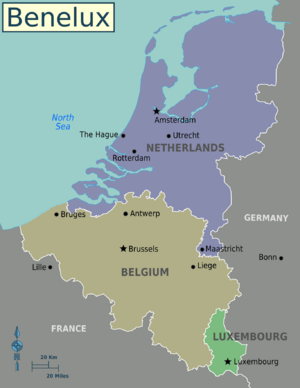Benelux facts for kids
Quick facts for kids
Benelux Union
|
|
|---|---|
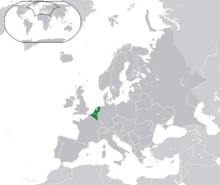 |
|
|
Member states of the Benelux Union

Luxembourg
Netherlands
Belgium
|
|
| Administrative centre and largest agglomeration |
Brussels 50°51′N 4°21′E / 50.850°N 4.350°E |
| Official languages | |
| Type | Politico-economic union |
| Member states | |
| Legislature | Parliament |
| Establishment | |
|
• Customs union treaty signed
|
5 September 1944 |
|
• Customs union in effect
|
1 January 1948 |
|
• Renewal signed
|
17 June 2008 |
|
• Renewal in effect
|
1 January 2010 |
| Area | |
|
• Total
|
75,140 km2 (29,010 sq mi) |
| Population | |
|
• 2024 estimate
|
|
|
• Density
|
405/km2 (1,048.9/sq mi) |
| GDP (PPP) | 2025 estimate |
|
• Total
|
|
|
• Per capita
|
|
| GDP (nominal) | 2025 estimate |
|
• Total
|
|
|
• Per capita
|
|
| Currency | Euro (EUR) |
| Time zone | UTC+1 (CET) |
|
• Summer (DST)
|
UTC+2 (CEST) |
| Driving side | right |
The Benelux Union is a special partnership between three countries in Western Europe: Belgium, the Netherlands, and Luxembourg. Its name, Benelux, comes from the first letters of each country's name. This union helps these countries work together on many things, like their economies and laws.
The Benelux region is busy and has many people. It makes up a big part of Europe's economy. Many people from these countries even cross borders to work in a neighboring Benelux country every day!
The main groups that help the Benelux Union run are the Committee of Ministers, the Council of the Union, and the General Secretariat. There's also the Benelux Parliament and the Benelux Court of Justice. The Benelux General Secretariat is located in Brussels. It helps manage all the cooperation efforts. The leaders of the Benelux Union take turns being president for one year. Luxembourg is the president for 2025.
Most people in Benelux speak Dutch or French. A smaller number speak Luxembourgish or German.
Contents
History of the Benelux Union
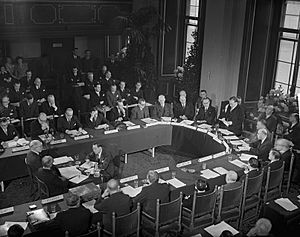
The idea for Benelux started in 1944. Representatives from Belgium, the Netherlands, and Luxembourg signed an agreement to create a customs union. This meant they would remove taxes on goods traded between their countries. This agreement officially began in 1948.
Over time, this economic cooperation grew. In 1958, they signed a new treaty to form the Benelux Economic Union. This union started in 1960. Its main goal was to allow people, money, services, and goods to move freely between the three countries. This was one of the first examples of European countries working closely together after World War II.
The Benelux Union helped set an example for other European groups, like the EU. The three countries also started the Schengen process, which allows people to travel between countries without passport checks. Today, Benelux cooperation goes beyond just economics. It also includes areas like safety and protecting the environment.

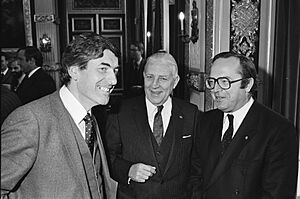
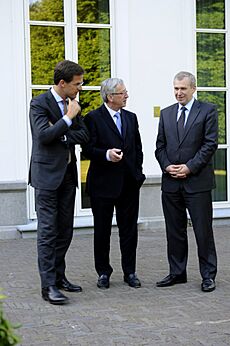
In 1965, they also created the Benelux Court of Justice. This court helps make sure that common Benelux laws are understood and used the same way in all three countries. Judges from the highest courts of each country work there. The court is located in Luxembourg.
Renewing the Benelux Agreement
The first Benelux Economic Union treaty was set to last for 50 years. As the European Union grew, the Benelux countries started working on new areas.
In 2008, the three countries decided to update their agreement. They signed a new treaty on June 17, 2008. This new treaty does not have a time limit. The name also changed from "Benelux Economic Union" to "Benelux Union." This new name shows that their cooperation is much wider than just economics.
The new treaty focuses on three main areas:
- Making trade and business easier.
- Working towards a sustainable future.
- Cooperating on justice and internal safety.
The Benelux Union also works with other European countries and groups.
Why Benelux Cooperation Helps
The Benelux Union brings many benefits to its member countries:
- Safety and Emergency Services: Police forces can work across borders to fight crime. Ambulances and fire services can also cross borders, helping people faster in emergencies.
- Recognizing Diplomas: If you get a diploma from a university in one Benelux country, it's automatically recognized in the others. This makes it easier to study or work in a different Benelux country.
- Economy and Transport: Removing paperwork and making digital documents helps businesses move goods across borders more easily and cheaply.
- Sustainability: The countries work together on clean energy and recycling. This helps create a greener future for the region.
The Benelux Union often tries out new ideas for cooperation. If they work well, these ideas can then be used by the larger European Union.
Benelux Activities and Projects
Benelux often works with other regions, like parts of Germany (North Rhine-Westphalia) and even countries in the Baltic and Nordic regions.
The Benelux Union is very active in protecting new ideas and inventions. They have an office in The Hague called the Benelux Office for Intellectual Property. This office helps people register trademarks and designs.
Here are some recent examples of Benelux cooperation:
- Since 2015, university degrees are automatically recognized across the Benelux countries.
- In 2014, they started common road inspections for vehicles.
- In 2017, they tested digital shipping documents for trucks.
- A new Police Cooperation Treaty in 2018 allows police forces to access each other's databases and even cross borders in some situations.
- The Benelux countries are also working together on how to deal with climate change. They have asked the European Commission to support cycling as a green way to travel.
In 2018, the Benelux Treaty celebrated 60 years. A Benelux Youth Parliament was also created that year. Leaders from the Benelux governments also meet regularly to discuss important topics.
Since 2017, Belgium and the Netherlands take turns protecting the Benelux airspace for NATO. Fighter jets are ready to respond quickly if needed.
Working with Other Regions
The Benelux countries also work with other groups, like the Pentalateral Energy Forum. This group includes France, Germany, Austria, and Switzerland. They work together on energy issues.
In 2017, Benelux members met with countries from the Baltic Assembly and the Nordic Council. They discussed working more closely on digital markets, social issues, and defense.
The Benelux Union has also signed agreements with Germany's North Rhine-Westphalia region and with France to strengthen cross-border cooperation.
How Benelux Works
The Benelux Union has five main groups that help it function:
- The Benelux Committee of Ministers
- The Benelux Council
- The Benelux Parliament
- The Benelux Court of Justice
- The Benelux General Secretariat
The Benelux Office for Intellectual Property is a separate but related organization.
Benelux Committee of Ministers: This is the highest decision-making group. Ministers from each country meet here. They decide the main goals and plans for Benelux cooperation. The presidency of this committee changes each year between the three countries.
Benelux Council: This group is made up of senior officials from different government departments. They prepare the topics and information for the ministers to discuss.
Benelux Parliament: This group was created in 1955. It has 49 members from the parliaments of Belgium, the Netherlands, and Luxembourg. They share information and give advice to their governments on Benelux matters.
Benelux Court of Justice: This is an international court. Its job is to make sure that Benelux laws are applied the same way in all three countries. If a national court has trouble understanding a Benelux law, it asks this court for a clear explanation.
Benelux General Secretariat: Based in Brussels, this office helps coordinate all the Benelux cooperation. It supports the meetings of the ministers and councils. It also helps start and manage projects in areas like economy, sustainability, and safety.
The Benelux Union follows a yearly plan that is part of a four-year work program.
Benelux Legal Tools
The Benelux Union uses different types of legal tools to achieve its goals:
1. Decisions: These are rules that the Benelux countries must follow. They help put the Benelux treaties into action. 2. Agreements: These are like traditional treaties. The Committee of Ministers can create them, and then the countries sign and approve them. They can cover any topic. 3. Recommendations: These are suggestions or guidelines from the ministers. They are not legally binding, but they are very important because they come from the highest political level. 4. Directives: These are instructions given by the Committee of Ministers to the Benelux Council or the General Secretariat. They help organize specific activities.
All these tools need the agreement of all three countries.
Benelux Countries
| Country | Belgium | Netherlands | Luxembourg |
|---|---|---|---|
| Official name |
|
|
|
| Official languages | |||
| Population (2024) | |||
| Area | 30,528 km2 (11,787 sq mi) | 41,543 km2 (16,040 sq mi) | 2,586.4 km2 (998.6 sq mi) |
| Population density | 385/km2 | 441/km2 | 260/km2 |
| Capital city | Brussels | Amsterdam | Luxembourg City |
| Largest urban areas |
|
||
| Form of government | Federal parliamentary constitutional monarchy | Unitary parliamentary constitutional monarchy | Unitary parliamentary constitutional monarchy |
| Current head of state | King Philippe | King Willem-Alexander | Grand Duke Henri |
| Current head of government | Prime Minister Bart de Wever | Prime Minister Dick Schoof | Prime Minister Luc Frieden |
| Main religions |
|
|
|
| GDP nominal (2025) | |||
| GDP per capita nominal (2025) | |||
| GDP (PPP) (2025) | |||
| GDP per capita (PPP) (2025) | |||
| Currency | Euro | Euro | Euro |
See also
 In Spanish: Benelux para niños
In Spanish: Benelux para niños
- Low Countries
- Nordic Council
- Visegrád Group



